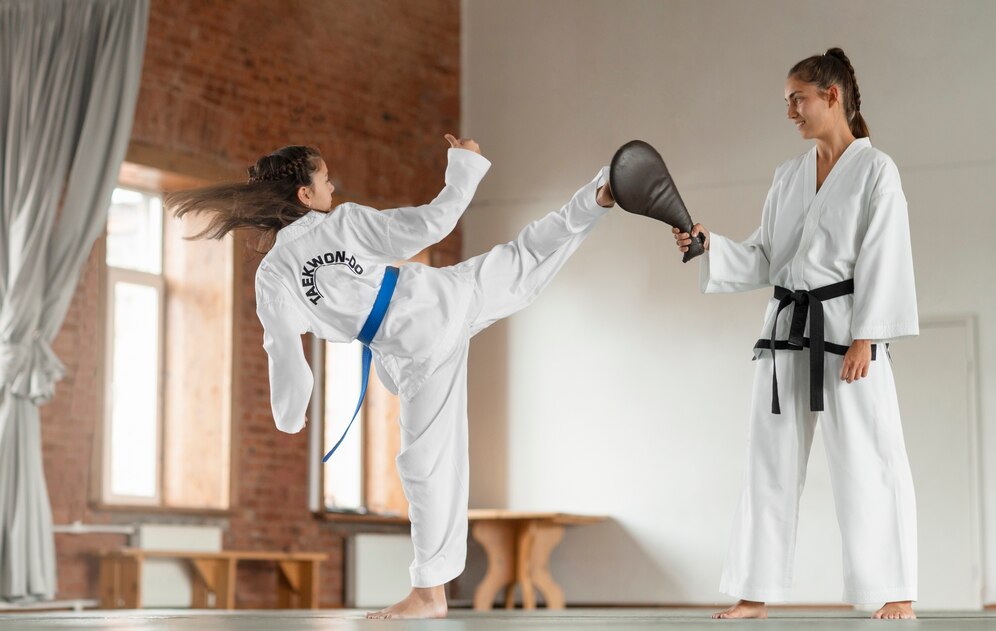Introduction
Taekwondo, a Korean martial art, is celebrated for its high-flying kicks, powerful strikes, and profound philosophical underpinnings. As a global phenomenon, Taekwondo attracts millions of practitioners who seek not only to master its physical techniques but also to internalize its ethical values. Enrolling in Taekwondo classes offers an unparalleled opportunity to engage in a disciplined training regimen that enhances physical fitness, cultivates mental discipline, and promotes personal growth.
The Structure of Taekwondo Classes
Warm-Up and Conditioning
Taekwondo classes typically begin with a warm-up session designed to prepare the body for rigorous physical activity. Conditioning exercises like push-ups, sit-ups, and squats are also integral to building strength and endurance.Discover the top 10 Taekwondo classes in Chennai for high-quality training and expert instructors. Elevate your skills with the best academies in the city.
Basic Techniques
After the warm-up, students practice fundamental techniques that form the foundation of Taekwondo:
- Kicks: Emphasizing the art’s distinctive kicking techniques, students learn various kicks such as the front kick (ap chagi), roundhouse kick (dollyo chagi), and sidekick (yeop chagi).
- Punches and Strikes: Hand techniques include the straight punch (jirugi), knife-hand strike (sonkal taerigi), and elbow strike (palkup taerigi).
- Blocks: Defensive maneuvers such as the high block (olgul makgi), middle block (momtong makgi), and low block (arae makgi) are essential for effective self-defense.
Patterns (Poomsae)
Poomsae are choreographed sequences of movements that simulate combat against imaginary opponents. Each pattern combines offensive and defensive techniques, helping students develop precision, balance, and coordination. Practicing poomsae is crucial for belt advancement and mastering the art’s techniques.
Sparring (Kyorugi)
Sparring sessions allow students to apply their skills in a controlled, competitive environment. Depending on the level of the class, sparring can range from light-contact drills to full-contact matches with protective gear. This practice improves timing, distance control, and strategic thinking.
Self-Defense (Hosinsul)
Taekwondo classes also include training in self-defense techniques. Students learn practical responses to various attacks, such as grabs, holds, and strikes. These techniques emphasize leverage, speed, and efficiency, making them effective for practitioners of all sizes and strengths.
Cool-Down and Reflection
Classes typically end with a cool-down session, consisting of static stretches and breathing exercises to promote relaxation and recovery. This period also provides an opportunity for reflection on the day’s training and the application of Taekwondo’s principles in daily life.
Benefits of Taekwondo Classes
Physical Fitness
Taekwondo offers a full-body workout that enhances cardiovascular health, muscle strength, flexibility, and overall physical fitness. Regular practice contributes to weight management, improved coordination, and increased agility.
Mental Discipline
The mental benefits of Taekwondo are profound. Training fosters concentration, focus, and mental clarity. The discipline required in Taekwondo promotes self-discipline, confidence, and a positive mindset, which can be applied in all areas of life.
Self-Defense Skills
One of the primary motivations for many to join Taekwondo classes is to learn self-defense. The techniques taught in Taekwondo are practical and effective, providing students with the skills needed to protect themselves in various situations. The emphasis on awareness and quick reflexes also enhances personal safety.
Social Interaction and Community
Taekwondo classes offer a supportive and inclusive environment where individuals of all ages and backgrounds come together to train. The camaraderie and mutual respect among practitioners foster strong social bonds and a sense of community.
Personal Development
The journey to achieving higher ranks in Taekwondo requires dedication, perseverance, and continuous self-improvement. This process encourages personal development and the pursuit of excellence. Achieving milestones in Taekwondo often translates into increased self-esteem and a sense of accomplishment.
Choosing the Right Taekwondo Class
Instructor Qualifications
When selecting a Taekwondo class, it is crucial to consider the qualifications and experience of the instructor. A certified instructor with a strong background in Taekwondo and a passion for teaching can provide high-quality training and mentorship.
Class Structure and Curriculum
Different Taekwondo schools may have varying approaches to teaching and class structure. It is essential to find a class that aligns with your goals, whether they are focused on competition, self-defense, fitness, or personal development. Observing a class or participating in a trial session can help you determine if the school is the right fit for you.
Facilities and Equipment
The training environment plays a significant role in your overall experience. Ensure that the dojang is clean, well-maintained, and equipped with the necessary training equipment, such as mats, protective gear, and targets.
Class Schedule and Location
Practical considerations such as the class schedule and location are also important. Choose a Taekwondo school that offers classes at convenient times and is easily accessible from your home or workplace.
Conclusion
Taekwondo classes provide a holistic approach to physical and mental well-being, combining rigorous physical training with the cultivation of important life skills and values. Whether you are looking to improve your fitness, learn self-defense, or embark on a journey of personal growth, Taekwondo offers a rewarding and enriching experience. By choosing the right class and committing to regular practice, you can unlock the many benefits that Taekwondo has to offer and embark on a path of continuous self-improvement and lifelong learning.Find the best Taekwondo classes in Chennai to enhance your martial arts skills. Join top-rated academies for professional training and expertise.





Comments